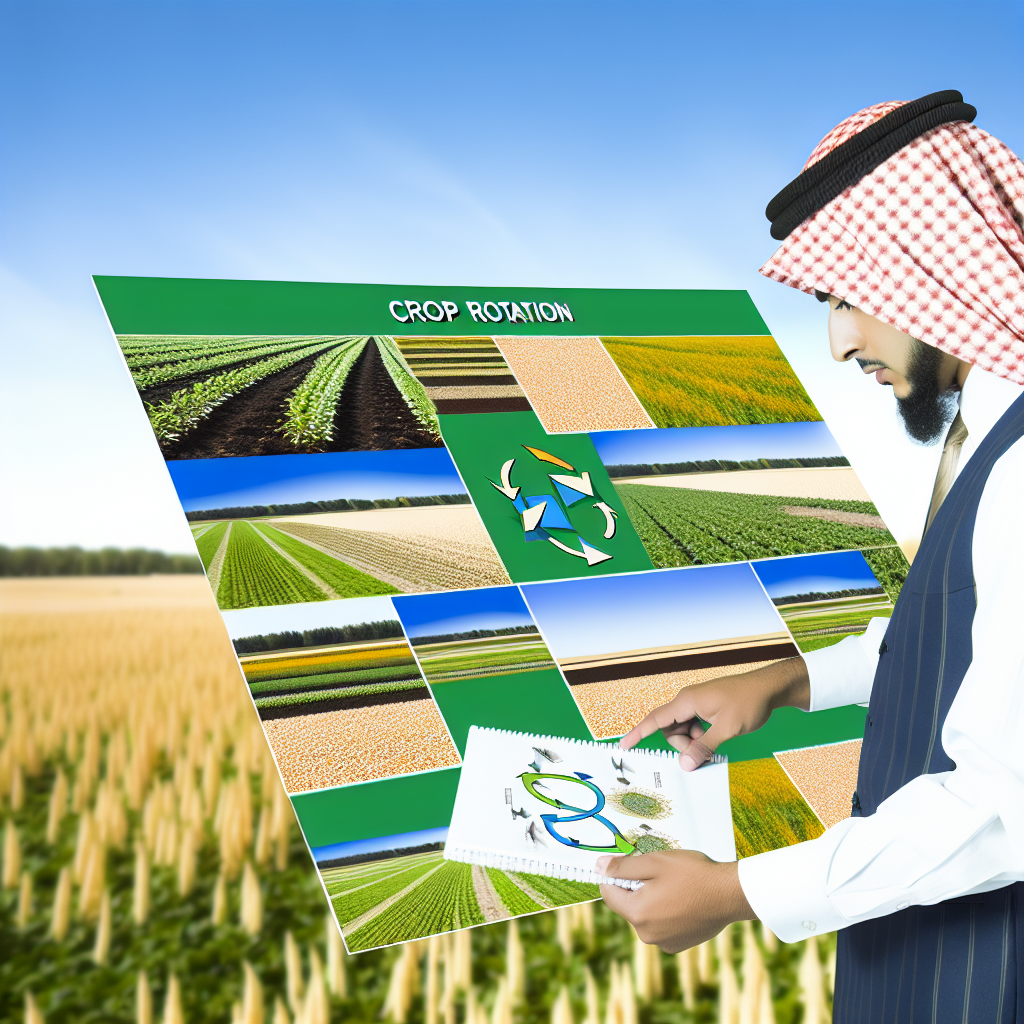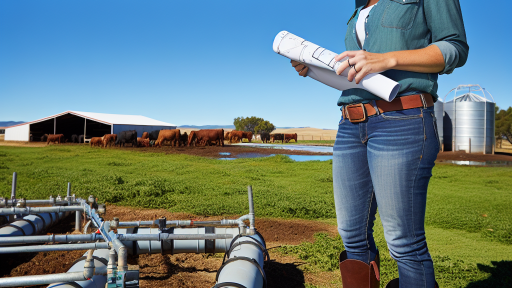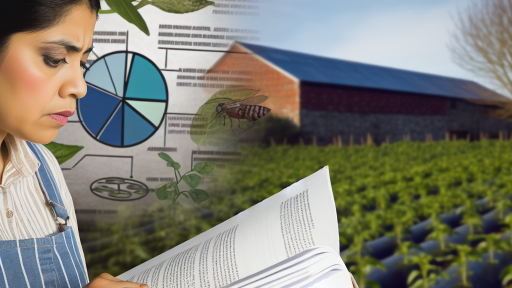Introduction to Crop Rotation and Its Importance for Biodiversity
Crop rotation is a farming practice that involves alternating different crops in the same field.
This technique enhances soil health and supports a diverse ecosystem.
It reduces pests and diseases, promoting a balanced environment.
In this section, we will explore the significance of crop rotation for biodiversity.
The Role of Crop Rotation in Enhancing Soil Health
Soil health is crucial for successful farming and biodiversity.
Crop rotation improves soil structure by preventing nutrient depletion.
Diverse root systems promote soil aeration and water retention.
Additionally, rotating crops can enhance microbial activity in the soil.
Impact on Pest and Disease Management
Crop rotation disrupts pest life cycles and reduces disease outbreaks.
Different crops attract different pests, preventing consistent infestations.
This practice can minimize the need for chemical pesticides.
Healthier ecosystems result from reduced chemical usage.
Contribution to Biodiversity Preservation
Biodiversity is essential for a resilient agricultural system.
Crop rotation fosters a variety of plants and organisms.
This diversity enhances ecosystem services, such as pollination.
Transform Your Agribusiness
Unlock your farm's potential with expert advice tailored to your needs. Get actionable steps that drive real results.
Get StartedMoreover, it creates habitats for beneficial insects and wildlife.
Long-term Agricultural Sustainability
Implementing crop rotation supports sustainable farming practices.
It reduces reliance on synthetic fertilizers and pesticides.
Over time, this leads to improved crop yields and farm profitability.
Ultimately, crop rotation cultivates a more sustainable future for agriculture.
How Crop Rotation Improves Soil Health and Structure
Enhancing Soil Nutrient Content
Crop rotation contributes significantly to soil nutrient content.
Different crops have varying nutrient needs.
For instance, legumes fix nitrogen in the soil.
This process enriches the soil for subsequent crops.
Improving Soil Structure
Crop rotation also enhances soil structure.
Diverse root systems from different plants penetrate the soil differently.
Some roots expand soil pores, improving aeration and drainage.
Consequently, this aids in preventing soil compaction.
Reducing Soil Erosion
Another benefit of crop rotation is its role in minimizing soil erosion.
Cover crops protect the soil from wind and rain.
Moreover, the presence of diverse crops maintains ground cover.
This guard against erosion helps preserve topsoil integrity.
Promoting Soil Microbial Diversity
Crop rotation fosters a diverse microbial community in the soil.
Each crop attracts different microorganisms.
This diversity supports healthy soil ecosystems.
As a result, beneficial microbes enhance nutrient cycling.
Breaking Pest and Disease Cycles
Implementing crop rotation disrupts pest and disease cycles.
Many pests are crop-specific and thrive on certain plants.
By rotating crops, farmers can reduce pest populations.
Showcase Your Farming Business
Publish your professional farming services profile on our blog for a one-time fee of $200 and reach a dedicated audience of farmers and agribusiness owners.
Publish Your ProfileThis approach ultimately minimizes reliance on chemical treatments.
Different Types of Crop Rotation Strategies
Sequential Crop Rotation
Sequential crop rotation involves changing the types of crops grown in a specific order.
This strategy enhances soil fertility by alternating deep and shallow rooting plants.
Consequently, it prevents the depletion of specific nutrients over time.
Farmers often see improved crop yields when implementing this method.
Additionally, it disrupts pest and disease cycles, reducing the need for chemical inputs.
Intercropping
Intercropping refers to growing two or more crops in proximity for mutual benefit.
This method can lead to better use of resources such as light and nutrients.
Moreover, intercropping reduces weed growth due to increased competition.
For instance, planting legumes alongside grains can enhance nitrogen availability in the soil.
This practice not only supports biodiversity but also stabilizes yields against pests and diseases.
Cover Cropping
Cover cropping involves planting crops that are not intended for harvest.
These crops cover the soil during the off-season, preventing erosion and nutrient loss.
They also improve soil structure and carbon content through organic matter addition.
Furthermore, cover crops can suppress weeds and reduce the requirements for fertilizers.
Farmers often see a significant improvement in soil health with consistent cover cropping.
Discover More: Building a Zero-Waste Farm: Strategies and Tips
Benefits of Crop Rotation for Pest and Weed Management
Enhancing Biodiversity
Crop rotation significantly enhances biodiversity on farms.
Different crops attract various beneficial organisms.
This diversity acts as a natural pest control mechanism.
Disrupting Pest Life Cycles
Changing crops disrupts pest life cycles effectively.
Many pests are crop-specific, meaning they thrive on particular plants.
When farmers rotate these crops, they can reduce pest populations.
This method lowers dependency on chemical pesticides.
Weed Management
Crop rotation is an effective strategy for weed management.
Different crops compete with weeds in unique ways.
This reduces the prevalence of particular weed species.
Additionally, it disrupts the yearly growth cycle of weeds.
Improving Soil Health
Healthy soil supports crop growth and pest resistance.
Rotating crops enhances soil structure and fertility.
This improvement promotes beneficial microbial life.
As a result, healthier plants can better withstand pests.
Reducing Chemical Use
Crop rotation can decrease reliance on synthetic herbicides and pesticides.
Farmers observe significant cost savings over time.
Furthermore, this practice leads to safer ecosystems.
It fosters a sustainable approach to farming.
You Might Also Like: Promoting Pollinators for Healthier Crops
Impact of Diverse Crop Rotations on Pollinator Populations
Enhancing Habitat Diversity
Diverse crop rotations create varied habitats for pollinators.
This variety supports different species of plants and flowers.
The presence of diverse flowers attracts a wider range of pollinators.
Showcase Your Farming Business
Publish your professional farming services profile on our blog for a one-time fee of $200 and reach a dedicated audience of farmers and agribusiness owners.
Publish Your ProfileAdditionally, increased floral resources extend the foraging period.
Providing Nutritional Resources
Diverse crops offer varied nutritional sources for pollinators.
Different plants bloom at different times, ensuring food availability.
This continuous supply of food helps maintain healthy pollinator populations.
Reducing Pesticide Exposure
Crop rotation can minimize the need for chemical pesticides.
Reducing chemical use leads to safer environments for pollinators.
Healthier ecosystems promote pollinator diversity and resilience.
Promoting Soil Health
Healthy soils lead to robust crop production.
Well-nourished crops attract a variety of beneficial insects.
This balance encourages natural pollination processes.
Case Studies of Successful Implementations
Many farmers have adopted diverse crop rotations.
For instance, a farm in Iowa uses a five-year rotation pattern.
The farmer has noted a significant increase in pollinator numbers.
Similarly, a farm in California reports enhanced crop yields and biodiversity.
These examples illustrate the positive impact of diverse crop systems.
You Might Also Like: Integrating Native Species on Your Farm

Case Studies of Successful Crop Rotation Implementations
Farmers in California
Farmers in California have adopted innovative crop rotation practices.
They rotate tomatoes, legumes, and cover crops.
This strategy increases soil nutrients while reducing pests.
As a result, yields have improved significantly.
Contribution of Gillian Farms
Gillian Farms showcases the importance of diverse crop rotation.
This farm rotates maize, soybeans, and barley effectively.
Such rotations enhance soil structure and biodiversity.
Moreover, this practice reduces reliance on chemical fertilizers.
Success in the Midwest
In the Midwest, Lee’s Family Farm implements a ring-based crop rotation.
This approach includes corn, oats, and clover in different patterns.
The diverse planting strategy reduces disease outbreaks.
Furthermore, it promotes a robust ecological environment.
Research at University of Florida
The University of Florida conducts comprehensive studies on crop rotation.
Their research focuses on watermelon, sunflower, and pepper rotations.
They found reduced pest populations in rotated plots.
This aligns with improved plant health and productivity.
Impact on Organic Farming
Organic farmers in Vermont utilize crop rotation for sustainability.
Crops such as potatoes, beans, and squash create beneficial soil dynamics.
This method fosters beneficial insect populations as well.
Consequently, these farms see less pest pressure compared to monocropping.
Uncover the Details: Soil Health and Carbon Sequestration Techniques
Challenges and Considerations in Developing Crop Rotation Plans
Understanding Local Conditions
Every farming environment presents unique challenges.
Soil type affects crop growth and rotation decisions.
Weather patterns also play a significant role.
Showcase Your Farming Business
Publish your professional farming services profile on our blog for a one-time fee of $200 and reach a dedicated audience of farmers and agribusiness owners.
Publish Your ProfileFarmers must consider local pest populations.
It’s essential to understand nutrient availability in the soil.
Choosing Compatible Crops
Selecting compatible crops isn’t a simple task.
Some crops may deplete the same nutrients.
Others may attract similar pests and diseases.
Farmers benefit from consulting agronomists.
Collaboration can lead to better crop pairing strategies.
Adapting to Market Demand
Market demand influences crop rotation planning.
Farmers need to anticipate changes in consumer preferences.
Short-term profits can sometimes overshadow long-term sustainability.
Balancing profit with ecological impact is crucial.
Farmers should stay informed about market trends.
Managing Labor and Resources
Crop rotation requires careful management of labor resources.
Timing planting and harvesting is essential for efficiency.
Farmers must also evaluate the cost of new seeds.
Budgeting for equipment changes can be challenging.
Assessing resource availability helps prevent overspending.
Environmental Impacts
Crop rotation has both positive and negative environmental impacts.
Improper planning can lead to soil degradation.
Farmers should assess the potential for erosion.
Water usage must also be factored into rotation plans.
Sustainable practices can help mitigate adverse effects.
Future Trends in Crop Rotation Research and Their Implications for Biodiversity
Advancements in Research Methodologies
Research methodologies in crop rotation are evolving rapidly.
Innovative technologies are enhancing data collection and analysis.
This includes the use of big data and machine learning.
Consequently, researchers can better understand crop interactions.
These advancements lead to more effective rotation strategies.
Focus on Agroecological Principles
There is a growing emphasis on agroecological practices.
These principles promote biodiversity and ecosystem health.
Researchers explore how diverse rotations affect soil quality.
Studies show that varied crops enhance nutrient cycling.
This supports the resilience of agricultural systems.
Integration of Climate Resilience
Climate resilience is becoming a key focus in research.
Scientists analyze how crop rotations can mitigate climate impacts.
This includes exploring crops that withstand extreme weather.
Such strategies can lead to sustainable food production.
Adaptation is critical as climate variability increases.
Collaboration Across Disciplines
Collaboration among diverse scientific fields is essential.
Plant scientists, ecologists, and agronomists are working together.
This approach fosters comprehensive understanding of crop rotations.
Showcase Your Farming Business
Publish your professional farming services profile on our blog for a one-time fee of $200 and reach a dedicated audience of farmers and agribusiness owners.
Publish Your ProfileInterdisciplinary projects drive innovation and implementation.
Partnerships with farmers also enhance practical applications.
Impacts on Biodiversity Conservation
Effective crop rotation promotes biodiversity conservation.
Diverse rotations improve habitat for beneficial organisms.
This includes pollinators and pest predators in agricultural lands.
Furthermore, varied cropping systems reduce reliance on chemicals.
As a result, ecosystems thrive and overall health improves.
Implementation of Policy and Education
Policy changes are needed to support sustainable practices.
Education also plays a vital role in adoption rates.
Farmers require training on the benefits of crop rotation.
Outreach programs can enhance understanding and engagement.
Ultimately, informed decision-making leads to better outcomes.
Additional Resources
Cover Crops for Sustainable Crop Rotations – SARE
What is Sustainable Agriculture? | Union of Concerned Scientists




